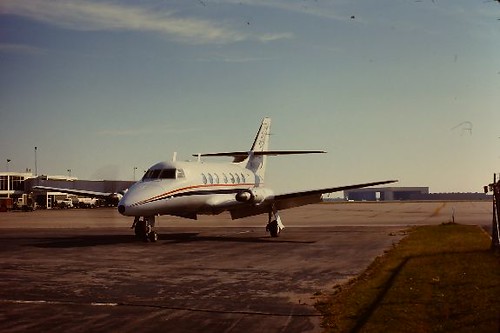British Aerospace Jetstream N815M
Image by San Diego Air & Space Museum Archives
Catalog #: Quastler282
Manufacturer: British Aerospace
Designation: Jetstream Airline: Jetstream Commuter
Serial Number: N815M
Details: "Date of photo: 06/24/1974 ; Note reads, ""Tulsa.""" Photo by I. E. Quastler
Repository: San Diego Air and Space Museum Archive
“CAD” or Computer Aided Design is used extensively within a variety of industries, from the design of perfume bottles to engineering design within aerospace industries. Due to its economic importance, CAD has been given a major role in the research of computational geometry and computer graphics. Due to its uniqueness, it is able to be applied to both hardware and software applications and is not limited to any specific industries or types of applications. This is proved by its capabilities, from architectural design to prosthetics and much more.
Three Dimensional simulation and a Lot More
Computer Aided Design systems were originally recognized as being limited in terms of use, for automated drafting. In the present day environment, CAD has assumed a position of product influence within many varied industries and applications. Instead of having to build prototypes at ever increasing costs and frequently changing components to determine tolerance ranges; computers are used to simulate actual operational conditions. Every product that is marketed, irrespective of size or weight, must endure an intensive process of design and analysis and computers are continuously making this process easier.
CAD has enabled computers with the creativity of design, whether an architect, engineer, professional designer or drafts-person. It is stated by the “National Science Foundation”, that Computer Aided Design may provide the largest productivity increase since the arrival of electricity. A question that arises however, is what implications does it have for the workers using it and the opportunities offered for future employment?
Commercial CAD systems have been obtainable since 1964. However, they could only be used on mainframe computers that were expensive and only affordable to the largest companies. With the advances made in technology by the computer industry, particularly with the production of “mini and micro” models, CAD technology has become available to a huge market of users, which is ever expanding.
To simplify the operation of a Computer Aided Design System; a drafts-person creates sketches or drawings on a computer screen. The tools and other materials used in a traditional drafting office have been replaced by a keyboard, graphics tablet, digitizer and light pen. Replacing an inked line on paper is a line of luminous phosphorus on the video console. By issuing a series of programmed directives, the drafts-person is able to produce a high quality, complete drawing or sketch, in far less time than previously produced by hand.
Most CAD systems generally offer four basic functions that to a great extent enhance the productivity of the designer or drafts-person. The first is “Replication”, which provides the user the ability to separate part of an image and then use this in other areas with repetitive features. “Translation” enables the transfer of features between different sections of the screen, while the feature of “Scaling” gives the ability to change the size of one part of a design, to view differently than another. The final basic is “Rotation”; a facility whereby you can select a desired angle, by either choosing two separate points, or by entering the angle of rotation on the keyboard.
The development and testing of new products is can be extremely time-consuming and costly. Each product is in some way, subjected to a measure of testing. This is not only to ensure it meets the required safety standards, but that it will also operate in the conditions and to the standards for which it was designed.
If a company is called to physically test each component as well as prototypes of the product, then the final costs and time factor, could reach well beyond the projected figures. With the use of CAD, there is not a need to test each design physically. A development team is able to conduct virtual stress tests and substitute equipment such as a wind tunnel with a CAD application that will simulate the exact conditions. Should a problem be discovered, then any conceptual design can be modified easily and quickly during the testing program.
Computer Aided Design permits the process of generating ideas to be creatively flexible. It is now affordable for enterprises to be more tolerant and open to new ideas and suggestions than previously and any new concept may be subjected to test more easily and at a greatly reduced cost. Suggestions for new products can be quickly tested at a lower cost than in the past, giving the opportunity for making even slight improvements on new product designs instantly.
Jason Kay recommends you search for engineering and design Cad jobs near you.
Nessun commento:
Posta un commento